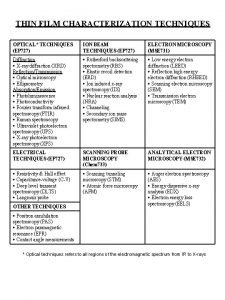SYNTHESIS AND CHARACTERIZATION TIO 2 POWDERS AND THIN

- Slides: 1

SYNTHESIS AND CHARACTERIZATION TIO 2 POWDERS AND THIN FILM OBTAINED BY SOLVOTHERMAL METHOD FOR APPLICATIONS IN ENVIRONMENT FRIENDLY BUILDING MATERIAL TECHNOLOGIES Florina Ştefania Rus 1 , Petru Negrea 2 , Paulina Vlăzan 1 , Ştefan Novaconi 1 Introduction The ability to fast obtain materials around specific application like design various new concept devices, such as gas sensors, catalysts, applications in environment friendly building material technologies with unique parameters of light absorption, solid state fuel cell, energy harvest, charge generation, and charge transport is thus vital to improving sciences and creating novel functionalities necessary for increasing implementation of photoactive materials [1]. X-ray diffraction (XRD) Experimental Ti. O 2 thin film and powders were synthesized by hydrothermal method, using the following reagents: -titanium isopropoxide -oleic acid - oleilamine Characterization X-ray diffraction (XRD) Raman Spectroscopy Scanning Electron Microscopy (SEM) Hydrothermal synthesis T= 180°C t = 12 h Thermal treatment T= 400°C t=4 h Atomic Force Microscopy Ultraviolet–Visible Spectroscopy UV-VIS) Photoluminescence Elipsometry Optical properties and images SAMPLES Optical band gap TEMPERATURE (OC) Ti. O 2 180 400 LATTICE PARAMETERS a b c 4. 65 4. 64 2. 61 CELL VOLUM CRYSTALLITE E SIZE V/ 106 Å pm 3 56. 57 60. 9 56. 3 97. 7 SPACE GROUP (NO. ) P 42/mnm XRD spectra of Ti. O 2 powder at different temperatures (a) and b) Rietveld fiting parameters Image of powder Ti. O 2 powder recorded with Scanning Electron Microscope (SEM) Ultraviolet–Visible Spectrophotometre Spectra of Ti. O 2 powder The inset figure is variable angle spectroscopic ellipsometry (VASE) of Ti. O 2 film 2 D and 3 D images of solvothermal Ti. O 2 film recorded with Atomic Force Microscop and Roughness Analysis Photoluminescence Raman Spectroscopy film nd ra de ow 2 p i. O f. T ao ctr pe n. S ma Ra λ = 410 nm, Slot excitation=15 Slot emission=7. 5 Summary ü Our research focus has been mainly on fast obtaining anatase Ti. O 2 in two forms: powder and film using solvothermal method ü Rietveld profile fitting of X-ray diffraction (XRD) pattern of the Ti. O 2 nanoparticles revealed highly crystalline anatase with P 42/mnm structure , no trace of rutile phase was detected in the XRD pattern. ü The anatase phases of Ti. O 2 could be sensitively identified by Raman spectroscopy based on their Raman spectra. According to group theoretical analysis there are six Raman active modes for tetragonal anatase structure. In our recorded spectra were observed only 3 active modes at 400, 518 and 645 cm-1 assigned as the B 1 g, A 1 g + B 1 g, and Eg. ü The band gap of Ti. O 2 powder from UV-Vis spectra revield a bandgap of 3. 65 e. V after Kubela-Munk plot ü The energy dependent ellipsometric angles Ψ and ∆ were recorded for 3 angles. Measurement of ellipsometry was performed in the spectral range 1. 24– 5 e. V at incident angles of 6570 -75°. The Ti. O 2 layer is approximated by a Kramers-Kronig consistent B-spline. Tauc plot was used to calculate the band gap (3. 65 e. V) ü The AFM Topography of film shows fine particles grouped in clusters and the height distribution maximum of Ti. O 2 film displays a broad maximum, Gaussian-like, which is reflected in the RMS roughness of the films. üThe results so far suggest the use of synthesized material for its integration into vitreous matrix (in volume or on the surface), especially in the foam glass used in environment friendly building materials technology Affiliations Acknowledgments 1 National Institute for Research and Development in Electrochemistry and Condensed Matter, 144 Păunescu Podeanu St, 300569, Timişoara, România Aurel 2 Politehnica University Timişoara, 2 Piaţa Victoriei, 300006, Timişoara, România e-mail: rusflorinastefania@gmail. com This work was supported by a grant of the Romanian Ministry of Research and Innovation, CCCDI–UEFISCDI, project number PN-III-P 1 -1. 2 -PCCDI-2017 -0391/CIA_CLIM -Smart buildings adaptable to the climate change effects, within PNCDI-III References [1] Elia Boonen and Anne Beeldens, Coatings, Recent Photocatalytic Applications for Air Purification in Belgium 2014, 4, 553 -573 24 th International Symposium on Analytical and Environmental Problems, Szeged, Hungary, 8 -9. October 2018.

